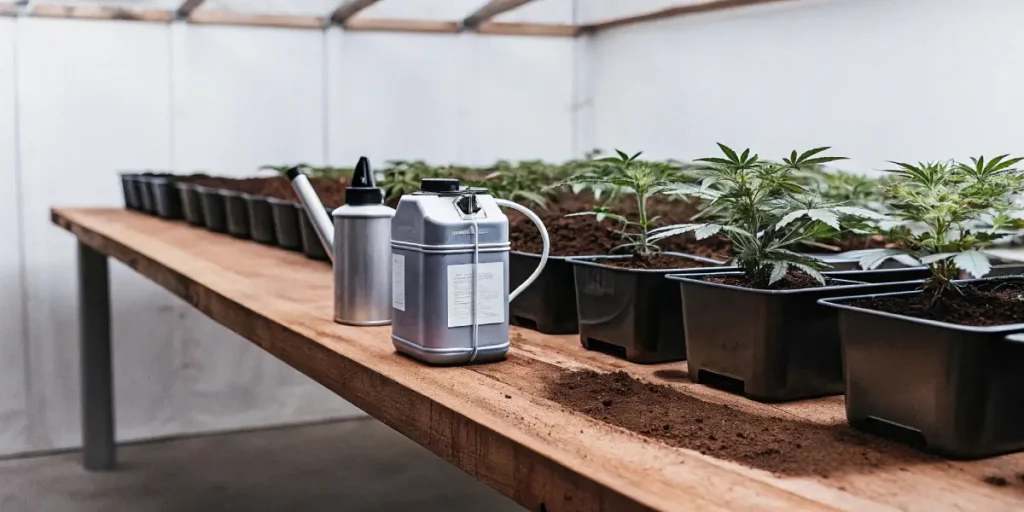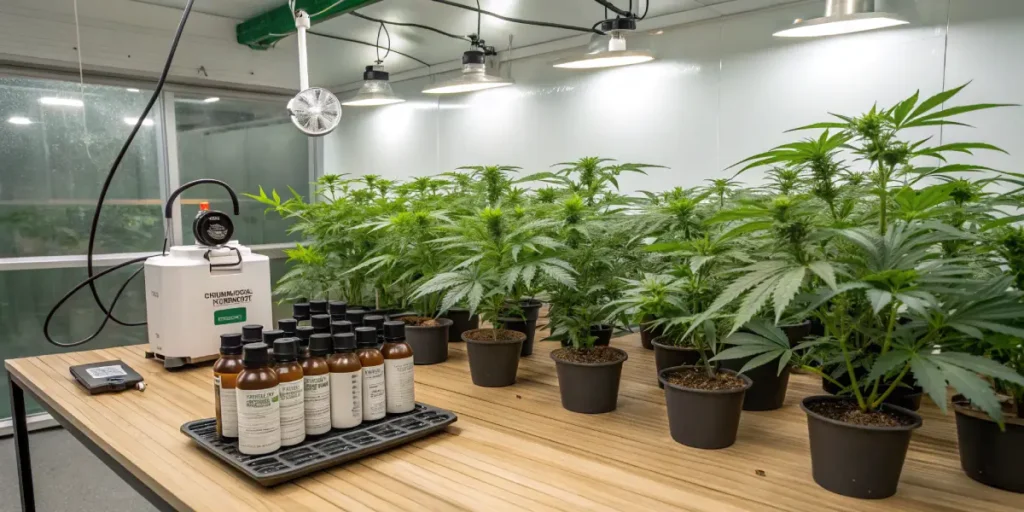
Best Nutrients for Autoflowers: Boost Your Cannabis Growth
Growing autoflowers can be incredibly rewarding, but to achieve the best results, choosing the right nutrients is crucial. Choosing the best autoflower nutrient kit can dramatically increase your yield, potency, and overall plant health. In this comprehensive guide, we’ll explore the best nutrients for autoflowers, focusing on how to optimize each growth stage for maximum success.
Why Autoflowers Have Unique Nutrient Requirements
Autoflowering cannabis strains differ from photoperiod strains in several key ways, which directly impact their nutrient needs. Autoflowers typically have a shorter life cycle, completing their growth in as little as 8 to 10 weeks. This rapid growth demands a precise nutrient regimen to ensure the plants develop robustly and produce high yields.
Recommended Strains
Critic Boom
|
|
THC | 20% - 25% (Medium) |
|
|
Type | Feminized |
|
|
Yield | High |
|
|
Phenotype | 40% Indica / 60% Sativa |
Critical 2.0 Auto
|
|
THC | 18% - 20% (Medium) |
|
|
Type | Autoflowering |
|
|
Yield | Medium |
|
|
Phenotype | 60% Indica / 40% Sativa |
Because autoflowers switch from vegetative growth to flowering based on time rather than light cycles, they require a balanced nutrient approach that supports both stages simultaneously. Overfeeding or underfeeding at any point can stunt growth, reduce yield, or even cause nutrient burn, which can be devastating given the limited time to recover.
Knowing the Growth Stages of Autoflowers
Autoflowers progress through distinct growth stages, each with its specific nutrient requirements. Realizing these stages and tailoring your nutrient schedule accordingly is key to maximizing your harvest.
- Seedling Stage: During the first two weeks, autoflowers are delicate and require minimal nutrients. A light, balanced feed with essential trace elements helps establish strong roots.
- Vegetative Stage: From weeks 3 to 5, the plants focus on growing foliage. Nitrogen-rich nutrients are essential during this stage to support leaf development and overall plant growth.
- Flowering Stage: Beginning around week 6, autoflowers start to bloom. Phosphorus and potassium become more critical during this stage to support bud formation and resin production.
- Late Flowering/Pre-Harvest: In the final weeks, reducing nitrogen and increasing potassium helps the plant finish strong, with dense, potent buds. Many growers also flush their plants with plain water to remove any remaining nutrients, improving the taste and smoothness of the final product.
Maximizing Autoflower Yields with Proper Nutrients
The best autoflower nutrients do more than just keep your plants alive; they directly influence the size, potency, and quality of your harvest. Autoflowers, with their rapid growth cycle, depend heavily on getting the right nutrients at the right time. Missing even a single feeding can result in smaller, less potent buds.
Nitrogen, phosphorus, and potassium (often referred to as N-P-K) are the primary macronutrients required by autoflowers. These elements drive essential processes like photosynthesis, cell division, and flowering. However, micronutrients like calcium, magnesium, and trace elements also play a vital role in supporting overall plant health, ensuring that your autoflowers have everything they need to thrive.
Promos & Deals
Essential Nutrients for Autoflowering Cannabis
Macronutrients: Nitrogen, Phosphorus, and Potassium (N-P-K)
Macronutrients are the building blocks of plant life, and for autoflowers, the most crucial are nitrogen, phosphorus, and potassium.

- Nitrogen (N): Vital during the vegetative stage, nitrogen promotes the development of lush, green foliage. It’s essential for photosynthesis and the production of chlorophyll, which powers the plant’s growth.
- Phosphorus (P): As plants transition to the flowering stage, phosphorus becomes critical. It supports the development of strong roots, promotes bud formation, and increases the plant’s overall energy.
- Potassium (K): Potassium is essential throughout the entire growth cycle, but it’s particularly important during flowering. It helps the plant withstand stress, supports water regulation, and boosts flower and fruit development.
Balancing these three nutrients is key to ensuring your autoflowers grow strong and healthy, with the potential for large, resinous buds.
Micronutrients: Calcium, Magnesium, and Sulfur
While macronutrients are crucial, micronutrients like calcium, magnesium, and sulfur also play vital roles in plant health and development.
- Calcium: Essential for cell wall structure, calcium helps the plant build strong tissues, preventing diseases and promoting overall vitality. A calcium deficiency can lead to weak stems and poor bud development.
- Magnesium: Magnesium is a core component of chlorophyll, the molecule responsible for photosynthesis. Without adequate magnesium, plants can’t effectively convert sunlight into energy, leading to stunted growth and yellowing leaves.
- Sulfur: Sulfur plays a role in the formation of essential oils and proteins, contributing to the plant’s aroma and flavor. It also aids in the production of enzymes and vitamins necessary for healthy growth.
Ensuring your autoflowers receive the right balance of these micronutrients is critical for maximizing yield and potency.
The Importance of Trace Elements in Autoflower Growth
Trace elements, though needed in smaller quantities, are no less important than macronutrients and micronutrients. Elements like iron, manganese, zinc, copper, and boron are involved in various enzymatic and physiological processes within the plant.
- Iron: Crucial for chlorophyll production, iron helps plants efficiently use energy from the sun, supporting robust vegetative growth.
- Manganese and Zinc: These elements are involved in photosynthesis and hormone production, contributing to overall plant vigor and the development of buds.
- Copper and Boron: These trace elements help with the formation of lignin, which strengthens cell walls, and are involved in the transport of nutrients within the plant.
Without these trace elements, autoflowers can suffer from various deficiencies, leading to poor growth and reduced yields. Most high-quality nutrient mixes include these trace elements, ensuring your plants receive a well-rounded diet.
Choosing the Best Nutrients for Autoflowers: What to Look For
When selecting the best nutrients for your autoflowers, it’s important to focus on the nutrient profile and how it aligns with your plants’ needs during each growth stage. Here are key factors to consider:
Balanced N-P-K Ratios
The N-P-K ratio (Nitrogen-Phosphorus-Potassium) on nutrient labels indicates the balance of these essential macronutrients. For autoflowers:
- Vegetative Stage: Look for a higher nitrogen ratio, such as 3-1-2, to support healthy leaf and stem growth.
- Flowering Stage: Shift to a nutrient mix with higher phosphorus and potassium levels, like 1-3-4, to promote bud development and resin production.
Micronutrient Content
In addition to the primary macronutrients, ensure that your nutrient solution includes vital micronutrients like calcium, magnesium, and sulfur. These elements are crucial for preventing deficiencies and supporting overall plant health. A well-rounded nutrient mix should also contain trace elements like iron, zinc, and manganese, which play critical roles in various physiological processes within the plant.
Solubility and Absorption
Autoflowers have a rapid growth cycle, so they require nutrients that are easily absorbed and quickly available to the plant. Water-soluble nutrients are ideal for this purpose, as they dissolve easily and can be absorbed directly by the roots. This ensures that your plants receive the nutrients they need without delay, supporting robust growth and higher yields.
pH Compatibility
Nutrient uptake is closely linked to the pH of your growing medium. To maximize the effectiveness of your feeding regimen, choose the best nutrients for autoflower in soil that are pH-balanced or adjust your nutrient solution to fall within the ideal pH range for autoflowers (6.0 to 6.5 for soil, and 5.5 to 6.0 for hydroponics). This ensures that your plants can efficiently absorb the nutrients provided, reducing the risk of nutrient lockout or deficiencies.
By focusing on these key characteristics when selecting nutrients, you can ensure that your autoflowers receive the precise support they need at every stage of growth, leading to healthier plants and more bountiful harvests.

How to Feed Autoflowers During Different Growth Stages
Nutrient Requirements During the Seedling Stage
The seedling stage is critical for establishing a strong foundation for your autoflowers. During this stage, the plants are highly sensitive, and overfeeding can easily stunt their growth.
For the first two weeks, it’s best to use a diluted nutrient solution, often at one-quarter strength, to avoid overwhelming the delicate roots. Focus on providing essential trace elements like calcium and magnesium, which support early root development and overall plant health. A light, organic nutrient solution or a specialized seedling formula is ideal during this stage.
Feeding Schedule for the Vegetative Stage
As your autoflowers enter the vegetative stage, their nutrient needs increase significantly. Nitrogen becomes the most critical element during this stage, as it supports the rapid growth of leaves and stems.
A typical feeding schedule during the vegetative stage might include:
- Week 3-4: Increase nitrogen-rich nutrients to support foliage growth. A balanced N-P-K ratio of 3-1-2 or similar is often recommended.
- Week 5-6: Continue feeding with a focus on nitrogen, while gradually introducing phosphorus and potassium to prepare the plant for the transition to flowering.
Throughout the vegetative stage, ensure that your plants receive consistent watering with pH-balanced nutrient solutions. Monitor for signs of nutrient deficiencies, such as yellowing leaves or stunted growth, and adjust your feeding regimen as needed.
Flowering Stage: Boosting Bud Development
The flowering stage is when your autoflowers will require the most attention in terms of nutrient management. During this stage, the focus shifts from nitrogen to phosphorus and potassium, which are essential for bud formation and resin production.
A typical feeding schedule during the flowering stage might include:
- Early Flowering (Week 7-8): Reduce nitrogen levels and increase phosphorus and potassium. A bloom booster with a ratio of 1-3-4 or similar is ideal.
- Mid to Late Flowering (Week 9-10): Further increase phosphorus and potassium to support bud density and trichome production. Consider adding supplements like molasses or specific flowering enhancers to boost terpene and cannabinoid profiles.
As harvest approaches, many growers choose to flush their plants with plain water to remove any remaining nutrients, improving the taste and smoothness of the final product. This process typically begins one to two weeks before harvest.
Tips for Avoiding Nutrient Burn and Deficiencies
Signs of Nutrient Burn in Autoflowers
Nutrient burn occurs when plants receive too many nutrients, causing the tips of the leaves to turn brown and curl. In severe cases, the entire leaf can become scorched, leading to stunted growth and reduced yields.
Common signs of nutrient burn include:
- Brown or burnt leaf tips
- Yellowing or discoloration of leaves
- Leaf tips curling upwards
- Slow or stunted growth
If you notice these symptoms, it’s crucial to flush your plants with plain, pH-balanced water to remove excess nutrients. After flushing, reduce the strength of your nutrient solution and gradually reintroduce it to avoid further damage.
How to Adjust Nutrient Levels Safely
Adjusting nutrient levels is a delicate process that requires careful monitoring of your plants. To avoid shocking your autoflowers, always adjust nutrient levels gradually. For example, if you need to increase the amount of phosphorus during the flowering stage, do so in small increments rather than making drastic changes.
It’s also important to regularly check the pH of your nutrient solution, as imbalances can lead to nutrient lockout, where the plant cannot absorb nutrients effectively. A pH range of 6.0 to 6.5 is typically ideal for soil-grown autoflowers, while hydroponic setups may require a slightly lower pH range.
Preventing and Correcting Nutrient Deficiencies
Nutrient deficiencies can manifest in various ways, depending on which nutrient is lacking. Common symptoms include yellowing leaves (nitrogen deficiency), purple stems (phosphorus deficiency), and weak, brittle plants (potassium deficiency).
To prevent deficiencies, ensure that your plants receive a balanced diet of both macronutrients and micronutrients. If you notice signs of deficiency, act quickly to correct the issue. This may involve adjusting your nutrient solution, adding specific supplements, or flushing the plant to remove any potential blockages.
Regularly monitoring your plants and keeping detailed records of your feeding schedule can help you identify and address nutrient issues before they become severe.
Organic vs. Synthetic Nutrients for Autoflowers
Pros and Cons of Organic Nutrients
Organic nutrients offer a natural, eco-friendly way to nourish your autoflowers. They are typically derived from natural sources like compost, manure, and plant extracts, and they work by feeding the soil, which in turn feeds the plants.
Pros:
- Promote healthy soil and microbial activity
- Improve the taste and aroma of the final product
- Reduced risk of nutrient burn and lockout
- Environmentally sustainable
Cons:
- Slower to act compared to synthetic nutrients
- Can be more expensive and labor-intensive
- Nutrient levels can be less predictable

Benefits and Drawbacks of Synthetic Nutrients
Synthetic nutrients are manufactured to provide precise, readily available nutrients to your plants. They are often preferred by growers looking for maximum control and immediate results.
Pros:
- Fast-acting and highly effective
- Easier to measure and apply
- Typically less expensive than organic options
- Provide exact nutrient ratios
Cons:
- Higher risk of nutrient burn and lockout
- Can harm soil health and microbial life
- May require more frequent flushing to prevent buildup
Combining Organic and Synthetic Nutrients for Optimal Results
Some growers choose to combine organic and synthetic nutrients to take advantage of the benefits of both. For example, you might use organic nutrients during the vegetative stage to promote healthy soil and microbial activity, then switch to synthetic nutrients during the flowering stage for a more precise boost.
When combining the two, it’s important to monitor your plants closely and adjust your feeding schedule as needed. This hybrid approach can offer the best of both worlds, resulting in healthy, high-yielding autoflowers.
FAQs About Autoflower Nutrients
Can You Overfeed Autoflowers?
Yes, it is possible to overfeed autoflowers, which can lead to nutrient burn, stunted growth, and reduced yields. Autoflowers are particularly sensitive to overfeeding due to their short life cycle and fast growth. To avoid overfeeding, start with a lower concentration of nutrients and gradually increase as needed, always monitoring your plants for signs of stress.
What’s the Best pH Range for Autoflower Nutrient Uptake?
The ideal pH range for nutrient uptake in soil-grown autoflowers is between 6.0 and 6.5. For hydroponic systems, a slightly lower pH range of 5.5 to 6.0 is recommended. Maintaining the correct pH ensures that your plants can absorb nutrients efficiently, preventing deficiencies and promoting healthy growth.
Do Autoflowers Need Different Nutrients Indoors vs. Outdoors?
While the basic nutrient requirements of autoflowers remain the same whether grown indoors or outdoors, environmental factors can influence how nutrients are absorbed. Outdoor plants may require additional nutrients to compensate for factors like soil depletion or weather conditions. Indoor plants, on the other hand, are often grown in controlled environments where nutrient absorption can be more predictable.
When growing outdoors, it’s important to test the soil and adjust your feeding regimen based on the natural nutrient content of the soil and the specific needs of your plants. Indoors, you have more control over the growing environment, allowing for a more tailored nutrient approach.




















